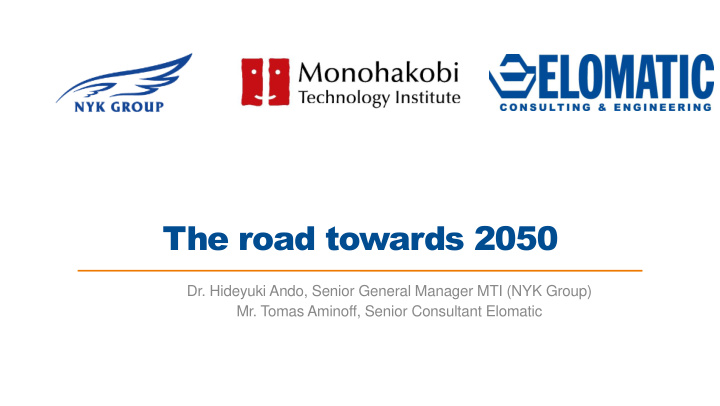



The road towards 2050 Dr. Hideyuki Ando, Senior General Manager MTI (NYK Group) Mr. Tomas Aminoff, Senior Consultant Elomatic
NYK LINE MTI (R&D Arm of NYK LINE) • • Head Office: Tokyo, Japan Established : April 1, 2004 • Founded: September 29, 1885 • Equity capital : JPY 99 million • Business Scope • Stockholder : NYK Line (100%) • Liner (Container) Service • Number of employees : 70 (as of 1st April, 2019) • Tramp and Specialized Carrier Services • Tankers and Gas Carrier Services • Logistics Service • Terminal and Harbor Transport Services • Air Cargo Transport Service • Cruise Ship Service • Offshore Service • Employees: 37,820 (as of the end of March 2017) • Revenues: $ 17.4 billion (Fiscal 2018) • Fleet: 792 vessels (as of the end of March 2019)
Now Future NYK/MTI’s path LNG HYDROGEN OIL toward smarter ship and operation Wind Resistance Reduced Super Eco Ship MT-COWL 2050 (Hardware) Super Eco Ship2030 Ship Alternative Marine Measurement around propeller Power 30 % Energy Saving PCTC Solar Panel Auriga Leader Hybrid T/C Wind Power Generator Shin Koho Andromeda Leader LNG-Fueled PCTC Delivery in 2016 LNG-Fueled Tugboat Innovative Sakigake Air Lubrication System MT-FAST SOYO Energy Saving Device Air Lubrication System Improved YAMATO, YAMATAI Electronic Controlled Engine Governor Controller Hybrid Electric Power LNG Bunkering Vessel Supply Auriga Leader Delivery in 2016 (Software) Operation Fuel Consumption LiVE Indicator Operation Portal Site FUELNAVI ShipDC & MTI Founded IoS-OP IBIS Project NYK’s own safety and Environment standard Integrated Operation Onboard Broadband NAV9000 Management System SIMS Detection of Mach. Trouble NYK Satcom Project NYK e- missions’ Prediction of Automatic onboard with monitoring data World First Current data collection system MASS Trial 2019 2003 2004 2005 2006 2007 2008 2009 2010 2011 2012 2013 2014 2015 2016 2017 2018
Background NYK Super Eco Ship 2050 NYK Super Eco Ship 2050 Continuous co-operation since 2009 with NYK Super Eco Vessel 2030 until today with NYK Super Eco Vessel 2050 To prepare a roadmap with actions from today towards 2050 Conceptual design to gain attention, provoke discussions and accelerate development Result: • 35% less resistance • 70% lower energy demand • Zero air and water emissions
Lightweight • Novel ideas for structures • 3D printing, new optimisation methods and new materials will allow for lighter design • Deck structure optimised by freeform optimisation algorithms • Lightweight reduced by 30%
Hull form • Lower lightweight enabled for rethinking of hull • Hull optimised for displacement and resistance only • Hull and superstructure with clean hull design, minimised resistance • Resistance 35% lower than in current ships of same size • Unstable by design utilising computer controlled active stabilisation devices • Stability for all situations ensured by active means: lowerable pontoons and gyroballs • Normally pontoons in sea skimming mode
Propulsion & Machinery • Flapping foil propulsion • Mimic the movement of dolphin • Efficiency beyond 85% • SOFC fuel cells operating on liquid hydrogen • Waste Heat Recovery and Cold Recovery • Solar panels with maximised area, two-axial tracking
Towards carbon free future EFFICIENCY ENVIRONMENT ENERGY - - - 35% Lower 70% Lower Zero emissions to air ship resistance energy demand and water
Key R&D agenda for 2030 NYK & MTI perspective • Electrification • Research for Fuel Cell • Hull & propulsion • Digitalization
Recommend
More recommend